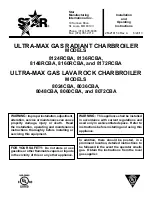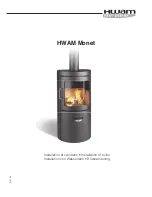
Fulton Boiler FBS Series
FBS 01/05 20
NOTE
Before leaving the boiler unattended, the daily operating tests should be carried out to check
the functions of all the safety interlocks. For more detailed information on the burner firing
sequence consult the burner manufacture’s Operation and Maintenance instructions.
PRACTICAL CONSIDERATIONS
When starting up the boiler, it is prudent to minimize the thermal and mechanical stress caused by
differential expansion of various parts of the boiler as they reach working temperature.
The temperature of the shell is determined by the contained water/steam temperature and by the heat
transfer rate and gas temperature. The tube temperature lies between the shell and furnace
temperature, but is nearer the shell temperature. Since all these components are virtually the same
length, they expend longitudinally by different amounts causing mechanical and thermal stress.
Whilst this is catered for in mechanical design of the pressure vessel, the life expectancy of the boiler
can be affected if the boiler is frequently heated to quickly from cold.
When starting from cold the furnace approaches its design temperature shortly after start-up,
whereas the tube and shell temperatures are delayed by the time taken to bring the contained water
up to temperature. As a result, the thermal expansion is at its greatest. Additionally, the temperature
gradient which exists between the bottom and the top of the boiler is exaggerated. This can be
reduced by blowing the boiler down during the heat-up period.
In practical terms, the ideal solution would be to gradually raise the temperature and pressure in the
boiler progressively by firing the boiler on low fire for a few minutes and leaving it to ‘soak’ (e.g.
allowing the temperatures in the boiler and water to even out by diffusion) for 20 to 30 minutes,
blowing down the boiler, firing the boiler again for a little longer and soaking for less, and so on.
If the boiler has been fired the day before, the large thermal mass in the boiler will maintain the
internal temperature to a point that the boiler can be simple switched on (preferably on low fire) and
then left to reach working temperature/pressure.
The life expectancy of the boiler and door insulation, ignoring other factors, is proportional to the
number of the thermal/mechanical cycles that the boiler undergoes from cold/zero pressure to
working temperature and pressure. A boiler that is continually maintained at working pressure will last
longer than that is constantly heated and cooled.
Service Inspection of Weld Joints.
The frequency of the safety requirement for in service inspection of the main welded joints of the
boiler is calculated by the number of cycles since the last inspection.
Boilers running twenty four hours a day require the shell and furnace end plate welds to be inspected
at five year intervals and the longditudinal seam every ten years.
Boilers that are continually heated and cooled require more frequent inspection.
The purpose of the in-service weld inspections ins to check for:
A. Buried defects during manufacture that are outside acceptable limits. Because the boiler was
100% tested during manufacture none should be found, and upon proof of 100% manufacture
testing these tests may be waived at the discretion of the ‘competent person’.
B. Cracks propagating from region of the toe of the fillet weld on the shell to the tube plate weld,
resulting from fatigue or corrosion fatigue cracking.
These cracks would no be there after manufacture but can develop in service, they are caused by
stress due to a combination of pressure loads, differential expansion, local temperature gradients,
oxygen impurities in the boiler water/steam and inadequate PH (water chemistry) control.
Differential thermal expansion and local temperature gradients all result from continuous
pressure/temperature cycling and heating from cold too quickly. Water treatment and in particular
oxygen corrosion are covered in Section 3. The importance of correct water treatment cannot be
over emphasized.
To achieve long trouble free boiler life:
1. Maintain the boiler at working pressure as long as possible.
2. when heating from cold do so slowly.
3. Maintain water treatment within the prescribed limits at all times.










































